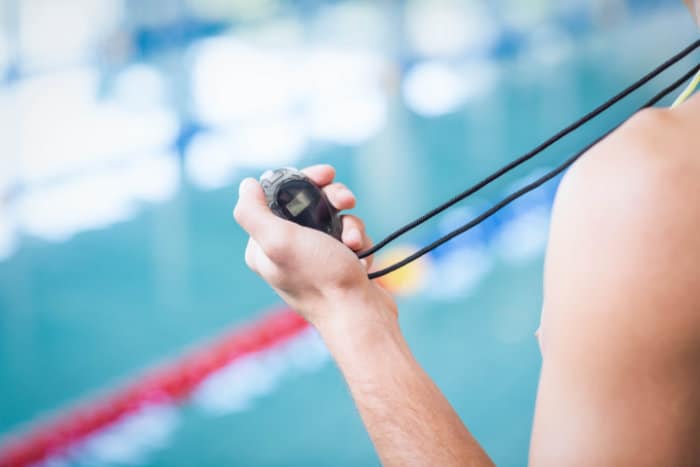Whether you swim for personal recreation or have competitive goals in mind, you’ll almost certainly benefit from improving your existing set of skills. For recreational swimmers, improved skills translate into increased confidence and a more relaxed attitude in the water. And for competitive swimmers, improvement in the pool often proves essential for meeting specific objectives such as making a team or winning an event. Whatever your motivation, you can take advantage of a very simple method of promoting skill improvement: timing yourself while doing laps for training. A brief rundown will help explain the details of this tried and true technique.
The Pace Clock
Any facility dedicated to training swimmers will have a pace clock (or lap clock) set up in a highly visible location. Unlike a traditional clock, this swimming-specific device does not have an hour hand. Instead, a pace clock displays time in minutes and seconds. At the top of the dial, in the place where you’d normally see the number 12, you’ll see the number 60, which designates the beginning of each minute as the red second hand rotates around. Time is highlighted in five-second intervals. Some clocks also come equipped with a black minute hand that advances every time the second hand completes a full rotation. In addition, some advanced pace clocks have digital readouts instead of analog readouts.
Timing Your Rest Intervals
Believe it or not, one of the most basic and important steps in improving your swimming is keeping track of the amount of time you rest between laps. Why? To begin with, most new swimmers have relatively poor technique, in terms of both breathing and body coordination. Instead of focusing on improving their technique, many swimmers (especially those who swim alone or outside of an organized environment) think they’ll get better just by doing more laps.
However, this approach is actually counterproductive. When you swim for as long as you possibly can without stopping, two things will likely occur. First, you will feel unduly fatigued as a result of the accumulation of carbon dioxide in your bloodstream. In addition, when you finally do stop, the unpleasant and draining feelings of fatigue will encourage you to rest for an extended period of time. The overall outcome of this scenario is reduced workout efficiency and delayed swimming improvement.
Instead of getting stuck in this trap, use a pace clock to keep track of the time you spend resting. Imposing discipline on your rest intervals provides you with a couple of important benefits. First, you’ll avoid “swimming yourself out” and increase your chances of staying within your current physical limitations. More importantly for your long-term improvement, you’ll also increase the odds that you will expand your limitations by improving your breathing control and gradually building up your physical fitness. A qualified swim instructor can help you set an appropriate rest interval for your current level of ability.
Timing and Controlling Your Pace
A pace clock also provides you with an excellent method of tracking your speed in the pool. The easiest way to begin using this technique is to start your first lap when the second hand on the clock reaches the “60” at the top of the dial. When you finish swimming your intended distance, take a look at the clock and note how much time has elapsed. You now know your current swimming pace for the stroke you used.
As you gain more experience in the pool, continue to use this timing method. Gradual improvements in your lap speed will help you keep track of your growing abilities and provide a measurable source of personal inspiration. You can also use the same basic approach when you swim sets of laps, although you’ll have to keep track of the math to use a pace clock for this purpose. Your instructor can help you learn how to efficiently calculate the intervals of your sets.
You can also use a pace clock to set or control your speed in the pool. This approach allows you to establish reasonable goals and mark your improvement by passing meaningful milestones. Whether you swim recreationally or competitively, these little victories will help keep you motivated and inspire you to make the most out of your time in the water.
Counting Your Stroke Rate
There is another timing-related technique that can help you improve your swimming capabilities: counting your stroke rate. Generally speaking, efficient swimmers use fewer strokes to travel a given distance than inefficient swimmers. Among other things, this means that tracking changes in your stroke rate can help you set goals for efficiency improvement. Start by determining the number of strokes it takes you to swim a given distance. Once you know this number, try to gradually lower your rate as part of your overall training plan. As in other areas of training, advice from a qualified swim instructor will help tremendously and allow you to maximize the benefits of swimming while maintaining adequate safety margins.



Sorry, but your advice to ask your coach or an instructor just meant I wasted every second I spent reading this article, because it told me nothing!
Why not entitle the article, Ask Your Coach or and Instructor!
I came to this article to find out how, not to be told to ask somebody else.
Geez!